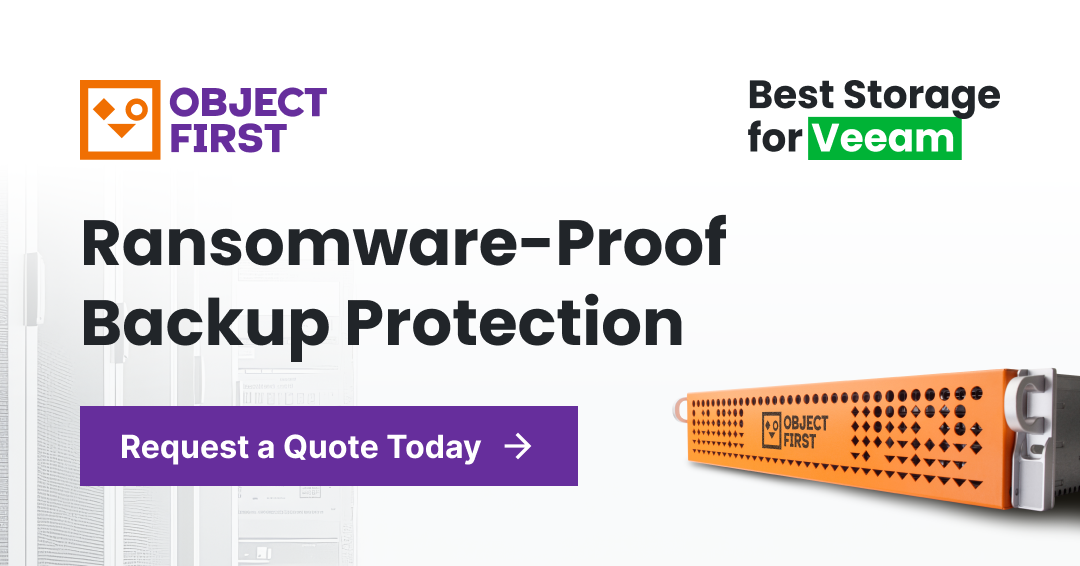Ransomware Backup Protection Strategy: Why Most Fail and What Actually Works
It all started with a single compromised password. By the time anyone noticed, files were locked, systems were encrypted, and operations were frozen. But the real panic hit when the team opened their backup console and found nothing. The backups were gone.
96% of ransomware attacks now target backups, because without them, recovery is off the table, and ransom is the only way out. So how to avoid this nightmare scenario? By building a ransomware backup protection strategy that holds strong under pressure.
In this guide, you'll learn the exact strategies for protecting your backups from ransomware and restoring your business in minutes without paying a single cent.
What Is Ransomware Backup Protection?
Ransomware backup protection is a key part of any modern data security strategy, explicitly focused on ensuring backup copies cannot be encrypted, deleted, or tampered with during an attack.
Cybercriminals no longer just target production systems but actively hunt for backups to block ransomware recovery and force ransom payments. Protecting backups from ransomware means they stay immutable, accessible, and ready for restoration when your entire infrastructure gets encrypted.
Put simply, ransomware-proof backups exist for one reason: to assure that your last line of defense stays intact, no matter how deep the data breach.
6 Industries That Must Prioritize Ransomware Backup Strategy
Threat actors don't strike randomly but go where disruption does the most damage. That's why sectors with legacy systems, uptime pressure, and valuable data are often their prime targets.
Here's who needs a robust backup strategy for ransomware most and why:
1. Manufacturing & Industrial Controls: Manufacturing accounts for 40% of ransomware incidents globally, with attacks on OT systems up 87% year-over-year. Legacy equipment, poor network segmentation, and limited isolation between IT and OT allow attackers to jump from admin laptops to plant floor PLCs, shutting down entire operations in minutes.
2. Finance & Insurance: 78% of financial services companies were hit by ransomware last year. These environments hold high-value data, real-time payment systems, and complex interdependencies, introducing exploitable gaps. Attackers often combine encryption with data exfiltration, leveraging regulatory exposure and public trust to force payouts.
3. Healthcare & Life Sciences: Healthcare was a top ransomware target in Q3 2024. Hospitals, labs, and pharmaceutical firms depend on constant access to EHRs, imaging systems, and connected medical devices. Even brief disruptions can delay care, violate compliance mandates, or halt time-sensitive research pipelines.
4. Education & Research Institutions: 83% of incidents in education involve personal data theft. Open networks, inconsistent patching, and a mix of legacy infrastructure and personal devices expand the attack surface. Combined with valuable research IP and limited IT resources, these sectors remain attractive targets due to a weak ransomware defense strategy.
5. Energy, Utilities & Logistics: Ransomware attacks on the energy sector rose 80% in 2024. As OT and IT environments converge, attackers exploit IoT, third-party software, and cloud-connected infrastructure to reach control systems. Whether disrupting oil pipelines, electric grids, or supply chain platforms, a single breach can trigger cascading failures with national or economic impact.
6. Government & Public Services: In 2024, 117 U.S. government entities were hit by ransomware, with encryption impacting more than half of the affected environments. Legacy infrastructure, chronic understaffing, and high uptime requirements make public-sector networks attractive targets, offering broad exposure and limited defenses across sprawling IT environments.
7 Best Practices for Protecting Backups from Ransomware
No ransomware backup strategy is complete without hardening the very systems attackers now target first—your backups.
The practices below go beyond theory to show what actually works. They are built to prevent tampering, block privilege abuse, and guarantee recoverable data in the event of ransomware.
Make Your Backups Truly Immutable
Data immutability works by locking information in place the moment it’s created. Instead of allowing edits or overwrites, any updates or changes must be recorded as entirely new entries, leaving the original untouched.
However, many vendors offering immutable backup storage actually deliver a policy-based configuration that can still be changed, bypassed, or disabled by administrators or attackers with elevated privileges.
At Object First, we define and advocate for True Immutability: a storage architecture that enforces Zero Access to destructive actions with its three non-negotiable components:
-
S3 Object Storage: Built on a fully documented, open standard with native immutability, enabling independent penetration testing and third-party verification.
-
Zero Time to Immutability: Backup data becomes immutable the moment it is written—no gaps, no landing zones.
-
Target Storage Appliance: Separates storage from backup software, eliminating DIY risks and offloading operational security to the vendor—no security expertise required.
With Zero Access at every layer, backups cannot be modified or deleted, regardless how compromised the environment is.
Apply the 3-2-1-1-0 Backup Rule
The 3-2-1-1-0 strategy is the modern evolution of the classic 3-2-1 backup rule—refined to defend against today's biggest threat: ransomware.
While still foundational, it no longer accounts for attackers specifically targeting backup data. That's why the updated 3-2-1-1-0 framework adds two critical requirements—immutability and integrity.
-
3 copies of data: One primary, plus two backups. This redundancy protects against corruption, failure, or compromise of any single copy.
-
Two different storage types: Ideally, a combination of distinct technologies—like block storage for production and S3-compatible object storage for backups—prevents shared vulnerabilities and simplifies segmentation.
-
1 off-site copy: Ensures geographic resilience. A cloud-based object storage target or a remote immutable appliance ensures that even region-wide incidents don't affect all data copies.
-
1 immutable copy: At least one backup must be write-once, read-many (WORM). It's best implemented on object storage platforms that support native immutability, such as S3 Object Lock in compliance mode.
-
0 backup errors: Every backup job should be verified automatically. That includes version validation, hash or checksum integrity checks, and alerts for incomplete or failed backups.
Extend Zero Trust to Data Backup and Recovery
Zero Trust has become the gold standard for cybersecurity, but ransomware makes one thing clear: trust boundaries must extend beyond users and endpoints to backup and recovery infrastructure.
That’s where Zero Trust Data Resilience (ZTDR) comes in, expanding the Cybersecurity and Infrastructure Security Agency’s (CISA) Zero Trust Maturity Model (ZTMM) to explicitly cover data backup and recovery.
Its core principles include:
-
Segmentation of backup software and backup storage to enforce least-privilege access, reducing the attack surface and minimizing the blast radius in case of a breach.
-
Multiple data resilience zones or security domains comply with the 3-2-1 backup rule, enforcing multi-layered security while isolating critical backup components.
-
Immutable storage to protect backup data from modifications and deletions. Zero access to root and OS, protecting against external attackers and compromised administrators, is a must-have as part of true immutability.
Integrating ZTDR into your ransomware protection strategy closes critical security gaps and removes the weakest link in many backup environments—implicit trust.
Automate Backup Testing and Verification
A backup that hasn't been tested might as well not exist. Ransomware often encrypts or corrupts backups silently, meaning you won't know there's a problem until restore time, when it's already too late.
Automated testing validates both the integrity and recoverability of your backups on a continuous basis, and here's how to do it right:
-
Integrity Checks: Perform automated checksums and hash validation to support ransomware detection and identify corrupted or altered backup data.
-
Automated Restore Drills: Regularly simulate full and partial restores to ensure you can meet your RTOs. This includes verifying app-level dependencies, not just raw data files.
-
Backup Job Monitoring: Set up automated alerting for skipped jobs, incomplete transfers, or unusual backup durations—often an early sign of compromise or misconfiguration.
-
Audit Logging: Keep immutable logs of test results and backup verification events. These double as compliance artifacts for audits or investigations.
Segment Backup Infrastructure from Production Networks
Ransomware thrives on a flat network architecture. If your backup infrastructure shares the same access pathways, identity stores, or privileges as your production environment, it's already compromised once the attackers get in.
To isolate backups effectively:
-
Separate Domains: Use different Active Directory (AD) forests or Identity and Access Management (IAM) policies for backup infrastructure.
-
Dedicated Admin Accounts: Never reuse production credentials for backup systems. Implement just-in-time access and Multifactor Authentication (MFA) for backup consoles.
-
Network Segmentation: Physically or logically segment your backup storage from your production Local Area Network (LAN). Use firewalls, Access Control Lists (ACLs), or Software-Defined Networking (SDN) rules to tightly control east-west traffic.
-
Air Gap Backups: Consider virtual air gaps through strict routing rules or dedicated VLANs if physical isolation isn't feasible.
Monitor for Anomalies in Backup Behavior
Ransomware doesn’t wait for your systems to respond. It moves fast and often undetected until the encryption starts.
That’s why behavioral monitoring is key to spotting unusual activity in and around your backup workflows, so you must watch for:
-
Unusual Access Patterns: Alert on backup deletions, modifications, or access outside expected hours or from unauthorized accounts.
-
Backup Job Size Anomalies: Sudden drops or spikes in backup volume could indicate encrypted data, deleted files, or replication issues.
-
Backup Console Logins: Track every login attempt, especially failed logins, login location changes, or new user creations on backup systems.
-
Write Patterns in Secure Data Storage: Object storage systems can flag suspicious write/delete spikes, a sign of tampering or ransomware payload deployment.
Harden Backup Credentials and Interfaces
Attackers frequently escalate privileges through stolen credentials, often targeting backup consoles first.
These systems hold the keys to restoring (or destroying) everything, so to harden access, make sure to:
-
Use MFA Everywhere: Enforce multi-factor authentication for all backup-related accounts—no exceptions.
-
Limit Admin Roles: Apply least-privilege principles rigorously. Don’t assign global admin access unless it’s absolutely necessary.
-
Rotate Credentials Regularly: Periodic key and password rotation ensures stale credentials don’t become an open door.
-
Disable Default Accounts: Many backup solutions ship with pre-configured admin accounts. Remove or disable them entirely after initial setup.
Make Your Backups Ransomware-Proof with Ootbi by Object First
If backups fail, your recovery plan, your operations, and in some cases your company fail with them. So building a ransomware backup protection strategy that actually works can be the difference between a fast restore and a seven-figure ransom.
At Object First, we believe no business should ever have to pay a ransom to recover its data. That's why we created Ootbi (Out-of-the-Box Immutability), which delivers secure, simple, and powerful on-premises backup storage for Veeam customers.
Ootbi is secure by design as defined by CISA. It was built around the latest Zero Trust Data Resilience principles, which follow an "Assume Breach" mindset that accepts individuals, devices, and services attempting to access company resources are compromised and should not be trusted.
Book a live Ootbi demo, and learn how to make your Veeam backups ransomware-proof.
Resources
Ransomware Encryption: Prevention and Response
Why Manufacturing Is The Biggest Target For Ransomware Attacks
US Cybersecurity in Finance: 2024
Industries most frequently impacted by ransomware in the United States in 3rd quarter 2024
Top Cybersecurity Statistics for 2025
Cyber Threats Against Energy Sector Surge as Global Tensions Mount
The State of Ransomware in the U.S.: Report and Statistics 2024


